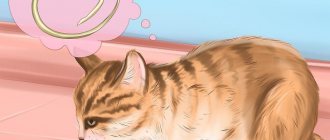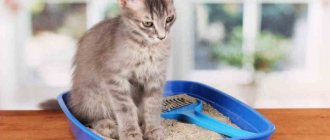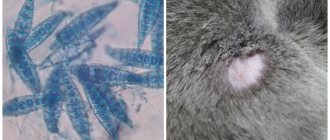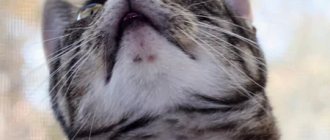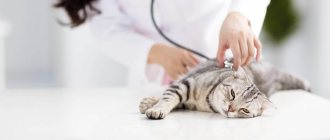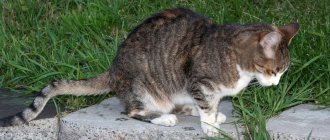- April 17, 2019
- Cats
- Evdokimova Irina
Ringworm is one of the most common skin diseases of cats. The first signs of pathology are not always obvious, because lichen rashes can be hidden deep under the fur. Often, owners pay attention to the condition of the pet’s coat and skin at a later stage, when the animal loses part of its hair. It is very important to provide timely and thorough treatment for lichen in cats. After all, this disease spreads easily. It poses a danger not only to other animals, but also to humans.
Types of pathology
By the term “lichen,” veterinarians mean a group of skin diseases that are accompanied by itching and the appearance of scaly rashes on the skin. These diseases are extremely contagious. Not only a stray animal can become infected, but also a cat that never leaves the house.
The following types of lichen occur in cats:
- Ringworm (microsporia, trichophytosis). This is the most common fungal disease in animals. It occurs in 90% of cases. The pathology is caused by the microorganisms Trichophyton and Microsporum.
- Pityriasis versicolor. This disease is the second most common. Its causative agent is a yeast fungus that is found on the skin and in healthy animals. The microorganism becomes pathogenic only with a sharp decrease in immunity.
- Pityriasis rosea. This is a fairly rare infectious allergic disease of cats. Pityriasis rosea is non-fungal in nature. Its causative agent has not been precisely identified, but veterinarians suggest that the disease is provoked by the herpes virus.
The greatest danger is caused by fungal forms of lichen in cats. Treatment of such pathologies should be immediate. As for pityriasis rosea, its manifestations often disappear on their own with good care of the animal.
Preventive measures
Prevention of ringworm is based on regular medical examinations of children attending preschool educational institutions. Parents should talk to their children about the inadmissibility of contact with stray animals. An important preventive measure is compliance with personal hygiene rules by patients of all age groups.
When purchasing pets, you must visit a veterinarian. The doctor will examine the cat or dog and give recommendations on how to eliminate any health problems with the pet. Following your veterinarian's advice will help prevent microscopic outbreaks within your family.
Causes
Fungal spores are very tenacious and small in size. Therefore, it is very easy to become infected with lichen. Most stray cats are infected with this disease. If a domestic pet comes into contact with its wild relatives, then infection occurs in almost 100% of cases.
Even cats that never go for walks often become infected with lichen. Pet owners can bring fungal spores into the house on shoes or clothes. Most often, weakened cats with reduced immunity get lichen. Long-haired breeds are especially susceptible to fungal infections.
Prevention of feline lichen
As a preventive measure, it is necessary to promptly identify foci of the disease and isolate infected representatives . Also recommended:
- Disinfect personal items and systematically examine children and pets.
- Observe personal hygiene rules.
- Take vitamin complexes in the autumn-winter period on your own or after consulting a doctor.
- If there is a risk of infection, regular sanitary cleaning of premises with chlorine-containing disinfectants will be useful.
- If domestic dogs and cats live in the country in the summer, they must be scanned with a Wood's lamp for the presence of trichophytosis or microsporia.
Ringworm is a harmless but very unpleasant disease. It can affect every person who neglects the rules of personal hygiene. And if your pet gets away with a small amount of broken hairs, then the person risks losing all his hair in a very short time. Therefore, it is important to take preventive measures in time or consult a doctor in a timely manner for treatment.
Symptoms
Ringworm is one of the most dangerous types of fungal skin infections. Without treatment, it can lead to baldness and even death of the cat. At the initial stage, a rash appears on the skin. However, in long-haired cat breeds, the rashes are very difficult to notice. The early stages of lichen can also be determined by changes in the pet's behavior. The cat becomes anxious and restless, constantly itches and loses its appetite. As the fungus spreads, the animal's hair falls out and scales appear on the skin.
With pityriasis versicolor, brown, yellow or pink spots appear on the animal's skin. Most often they are localized on the paws, head or neck. These rashes are subtle and may periodically disappear and then reappear. Pityriasis versicolor is usually not accompanied by severe itching.
Pityriasis rosea most often appears in kittens or older animals. In cats, small pink spots appear on the skin, reminiscent of allergic rashes. These manifestations last about 6 - 9 weeks and then disappear. However, spots may reappear when immunity decreases.
What to do if you notice signs of lichen in your cat? Only a specialist can treat and identify such pathologies. After all, lichen is very easy to confuse with other types of skin diseases. You need to take your pet to the veterinarian as soon as possible. The doctor will examine the skin using a Wood's lamp. If you direct the light of the device to the affected area, a bluish or greenish glow appears when the lichen occurs. If necessary, scales are scraped from the area of the rash and sent for microscopic analysis.
How to identify ringworm in a cat at home?
- -one of the first signs that should alert you is that the cat scratches itself often, eats poorly, and does not behave as usual. What happens, what should you pay attention to, how does lichen begin in cats?
- - round flaky spots appear. In some cases, spots appear all over the body. Ringworm often appears in cats on the ears, paws, and face. It all depends on the specific pathogen;
- - crusts form at the spots;
- - hair falls out;
- - your cat itches a lot, often chews and scratches spots;
- - scabs appear along the spine;
- -spots expand and take on an oval shape;
- - in places where the rash appears, the hair thins and the hairs become sparse;
- - the spots grow, if treatment is not started, your pupil will die.
Briefly about the atypical form of ringworm. The fact is that the signs of lichen described above in this form of the disease are absent or not clearly expressed. The disease proceeds unnoticed, since only individual hairs are affected. This is the danger of this disease. The owner does not suspect anything, since he does not see signs of infection, does not take any measures for a long time, and the disease develops.
Early stage therapy
What to do if your cat has shingles? The choice of treatment method depends on the stage of the pathology. If the disease can be detected at an early stage, then treating lichen is much easier.
Treatment of ringworm in cats at the initial stage begins with the administration of antifungal vaccines. Vaccination stimulates the immune system, and the body copes with the pathogen on its own. This method of therapy only helps if lichen is diagnosed at a very early stage.
The following drugs are used for vaccination:
- "Vakderm" and "Vakderm F". These vaccines contain inactivated fungi that cause ringworm. The drug "Vakderm F" also contains immunomodulators. The vaccination is done twice. Immunity is formed in 25 - 30 days and lasts for 12 months.
- "Polivak TM". The vaccine contains inactivated fungal particles. When they enter the bloodstream, they activate the body's defenses. If the vaccine is used to treat lichen in cats, the drug is administered 2 - 3 times with an interval of 10 - 14 days. After 20-25 days, the animal’s body begins to produce antibodies against fungi, and the affected areas of the skin gradually become covered with hair.
- Microderm. This drug is a live vaccine. It contains weakened strains of fungi. The vaccination is given once. After just 15 days, lichen crusts on the animal’s skin begin to loosen and fall off, and after 20–25 days, hair growth is restored. Immunity lasts for 1 year.
The cat must be dewormed 10 days before vaccination. Vaccines should not be administered to kittens under 2 months of age, as well as to females during pregnancy and nursing.
In some cases, immunomodulators are used to treat lichen in cats at an early stage:
- "Ribotan." This is a drug based on natural substances that strengthen the immune system. It is important to remember that this remedy does not affect the fungus in any way, it only helps the body fight the causative agent of lichen. The immunomodulator is injected into the muscle or under the skin once a day.
- "Anandin." The active component of the drug promotes the production of interferon and antibodies against fungi. This remedy is most often prescribed to dogs, but it is quite suitable for cats.
The use of vaccines and immunomodulators must be combined with the treatment of wool with antimycotic ointments, gels and shampoos.
How to avoid getting shingles from a cat?
Firstly, do not have contact with stray animals and do not allow children to do this. After walking, be sure to wash your hands. If you have a cat, take it to the vet to have it checked for ringworm. Clean the apartment regularly using disinfectants. Be sure to treat your cat for parasites. It is important to provide your pet with a nutritious diet; this helps maintain its good condition, increases immunity, and therefore the skin’s resistance to infections.
Now let’s look at where cats get lichen from? Your pet can become infected through contact with a sick animal. And even without communicating with one, yours can become infected simply by walking in the country. Ringworm spores can be found on the soil. Sometimes you yourself are the cause of your absolutely domestic furry's illness. The fact is that you can bring fungus into your home on clothes, shoes, and things. Sometimes small children infect their pets. The child stroked a cute cat on the street and, when he came home, stroked his own. And that’s it, contact happened.
What can be observed with all types of lichen in cats:
- - hair falls out;
- - the skin becomes inflamed and peels;
- - areas of the skin become inflamed;
- - severe itching appears;
Rules for processing wool
How to cure lichen in a cat? Before applying antifungal agents, you need to carefully trim the hair on the affected areas. After this, you must thoroughly disinfect or throw away the scissors. It is important to remember that ringworm is very easily transmitted to humans, not only through contact with a cat, but also through animal care items.
If you use napkins and cotton swabs to apply medications, the hygiene products must be thrown away immediately. Immediately after processing the wool, you need to wash your hands and then wipe the skin with an antiseptic.
After completing the procedure, it is necessary to carry out wet cleaning with bleach, since there may be contaminated wool particles on the floor. Then you should disinfect the room using a quartz lamp.
Routes of infection
The causative agent of microsporia enters the body when a healthy person comes into contact with a carrier of the disease. An alternative way is to interact with objects covered with fungal spores. Ringworm is most often detected in children aged 5-10 years; in boys, microsporia is diagnosed five times more often than in girls. The pathology almost does not affect adults due to the presence of organic acids in their hair structure, which suppress the growth of fungal mycelium.
The reasons for the development of ringworm are microtraumas of the skin and its dryness. Spores get into cracks, scratches or open calluses. Healthy skin becomes an insurmountable barrier to fungus. The pathogen does not survive contact with personal hygiene products - thorough hand washing after contact with spore carriers eliminates the possibility of infection.
The risk group includes people who regularly come into contact with the ground and wild animals. The active growth of the fungus is facilitated by disturbances in the functioning of the sebaceous glands due to changes in the chemical composition of their secretions. Microsporum spores can remain viable for three months when left in open ground.
Antiseptics
Before applying antifungal agents, it is necessary to treat your pet's skin with antiseptics. When treating lichen in cats at home, alcohol solutions of iodine and brilliant green should not be used. These products can cause burns and, in some cases, a severe allergic reaction.
The need to use antiseptics is due to the fact that cats experience severe itching and often scratch their skin. This can lead to bacterial complications of lichen and significantly complicate treatment.
Veterinarians recommend using the following antiseptics to treat ringworm in cats at home:
- "Salicylic alcohol". This antiseptic destroys both bacteria and fungal colonies. It inhibits the formation of proteins in the spores of the causative agent of lichen. Clean the skin with alcohol twice or thrice a day before applying topical antifungal agents.
- "Fukortsin". This is a red solution that has antibacterial and antifungal properties. The drug consists of a mixture of several antiseptic substances. After using Fukortsin, it is necessary to monitor the animal’s condition. The drug contains phenol; this component can cause lethargy and drowsiness in animals.
If the skin already has scratches and scratches, then the affected areas are treated with hydrogen peroxide or furatsilin solution. These antiseptics have predominantly antibacterial properties. They will help avoid the appearance of inflammation and pustules.
Symptoms of lichen in humans from cats
As mentioned above, ringworm is contagious to humans. Children are infected first, then people with weakened immune systems and allergy sufferers. What happens to a person infected with lichen from a cat?
After infection, the disease may appear from several days to several weeks. Ringworm can appear on the body, nails, and head. Peeling spots appear on the skin, spots grow, and the skin turns red. Round, flaky bald spots appear on the head (the area looks as if someone has shaved it), and grayish spots appear on the nails, which leads to their fragility. Unlike cats, lichen in humans generally occurs without complications. If you discover suspicious, unknown skin diseases, immediately go to a dermatologist.
Antifungal ointments
How to cure lichen in a cat with local remedies? For therapy at home, ointments, gels, drops, sprays and shampoos can be used. These products contain antifungal components.
The most popular antifungal drugs include:
- "Clotrimazole". The active component of the drug is the antimycotic substance clotrimazole. It inhibits the formation of proteins in the membranes of fungal cells. It is recommended to apply the drug to lichen rashes three times a day. The duration of therapy is usually about 1 month. The ointment should not be used on pregnant or lactating cats.
- "Miconazole". The active component of the ointment is miconazole nitrate. This substance acts similarly to clotrimazole. The ointment is applied twice a day. This drug is effective for ringworm and pityriasis versicolor in cats. Treatment takes from 1 to 2 months.
- "Sanoderm". This is a combination drug based on clotrimazole. It also contains betameson (an anti-inflammatory corticosteroid), gentamicin (an antibiotic) and nipagin (an antiseptic). The drug is applied to the affected area twice a day. The drug contains hormones, so it can be used for no more than 4 weeks. If a repeated course of treatment is necessary, then you need to take a break of 20 days.
After applying the ointments, you must put a protective collar on the cat. This will prevent the drug from being licked off. Many topical antifungal agents can be toxic if swallowed.
A relatively new drug is the Imaverol emulsion. Its active ingredient is the antimycotic substance enilconazole. During the entire course of treatment, the emulsion is applied to the affected areas 4 times with an interval of 3 to 4 days. This drug is considered the most gentle remedy, since enilconazole rarely causes side effects.
After just a few days of local treatment for lichen, the itching in cats is significantly reduced, and the scales on the affected areas begin to peel off. 1 - 2 months after using the ointments, the lichen rashes completely disappear.
Other types of ointments
In addition to antifungal drugs, there are other treatments for lichen in cats. These include ointments based on sulfur and other chemical compounds:
- Sulfuric ointment. When applied to the skin, sulfur is converted into sulfides and pentathionic acid. These substances have a detrimental effect on fungal spores and also promote wound healing.
- Sulfur-tar ointment. Birch tar enhances the healing properties of sulfur. It has antipruritic and wound healing properties.
- Sulfur-zinc ointment. The antifungal effect of sulfur is complemented by the anti-inflammatory properties of zinc.
- Sulfur-salicylic ointment. This drug has a weaker antifungal effect, as it contains a small amount of sulfur (2%). But it contains salicylic acid, which relieves inflammation and promotes skin regeneration. This type of ointment is recommended for use in combination with other antifungal agents.
- Ointment "Yam". In addition to sulfur, this product contains birch tar, salicylic acid, zinc and turpentine. The drug destroys fungal spores, relieves inflammation and promotes skin healing.
All varieties of sulfur ointments can be used to treat ringworm in cats. In the photo you can see how the drug is applied to the skin.
It is very important to treat not only the rash itself, but also the area around it. These ointments do not cause side effects even when applied to large areas of the skin.
Symptoms
Ringworm on the face and body appears in the form of pink or red circles raised 1-3 mm above the surface of the skin. The lesions are characterized by clear boundaries, while pale areas of skin with red dots are visible inside. These spots quickly increase in size. Their number is growing over time.
The skin inside the lesions becomes covered with a white crust, which peels and itches. Ringworm on the scalp is characterized by split hair and hair loss. As the number of lesions increases, they begin to connect and overlap each other. Ringworm on the body occurs with increased symptoms when the pathogen gets inside existing lesions, and new fungal rings form in them.
Shampoos
How to cure lichen in cats using shampoos? These products are recommended to be used in combination with antifungal ointments. This will significantly speed up the healing process.
For ringworm and pityriasis versicolor, the use of shampoos based on antifungal components is indicated. Most often, veterinarians prescribe the following medications:
- "Nizoral." This is one of the most effective drugs against pityriasis versicolor and ringworm. Its active component is ketoconazole. This substance destroys the fungus and stops its spread through the skin.
- "Sebozol." This shampoo is an analogue of Nizoral in terms of the active ingredient. However, its price is much lower. The product is also available in the form of an ointment, which is recommended for use with shampoo.
Antifungal shampoos have a fairly short period of action. Therefore, they should not be used as the only treatment for lichen in cats. In the photo below you can see how wool is treated with shampoo.
Such water procedures must be carried out several times a week. The shampoo must be applied to the coat and left for the time specified in the instructions (about 10 - 15 minutes). The effect becomes noticeable after 6 - 7 weeks. Antifungal shampoos should not be mixed with conventional hygiene products for washing wool.
Diagnostics
Lichen is diagnosed using three types of research:
- The most reliable results can be obtained by sowing on a nutrient substrate. Material is taken from the source of the disease and placed in a special environment that ensures the development of the fungus. Such a study makes it possible to accurately determine the causative agent of the infection, but its disadvantage is the duration of the process. Results can only be obtained after 3 weeks.
- The next type of research is analysis of the material under a microscope. To carry it out, the veterinarian scrapes out fragments of the cat’s skin and fur from the affected area. Then, using a microscope, the collected material is examined for the presence of fungal spores.
- Diagnostic methods also include irradiation with a Wood's lamp. The device emits ultraviolet light, the wavelength of which has a certain length. This analysis has become most widespread due to its speed. When exposed to radiation, mushrooms and their metabolic products begin to emit a greenish glow. But such research is not without its drawbacks. Glow also occurs when various chemicals are present on the fur and skin. For example, medications. For this reason, radiation cannot be used as the only diagnostic method.
If there are other animals in the house in addition to the infected cat, they also need to be checked for the presence of the disease. Even in the absence of visible signs. As a rule, in such a situation, all pets are affected by the fungus.
Tablet drugs
How to treat a cat for lichen if the disease is already advanced? In severe cases, it is impossible to manage only with the use of local remedies. It is necessary to take antifungal medications in tablets.
However, it is not recommended to bring the pathology to such advanced stages. After all, antifungal medications in tablets are often toxic and have a large number of side effects.
The most common drugs from the triazole group are:
- "Itraconazole"
- "Ketoconazole".
- "Fluconazole".
These agents suppress the formation of protein in fungal cells, which leads to the death of the microorganism. Antifungal drugs from the triazole group can have toxic effects on the liver and kidneys. Therefore, during the course of treatment it is necessary to periodically examine the function of these organs.
In some cases, Griseofulvin is prescribed, an antimycotic antibiotic that disrupts the cellular structure of the fungus and suppresses the proliferation of the microorganism. This is an old but quite effective remedy for treating ringworm in cats at home. The tablets can be crushed and added to food. This antibiotic is strictly contraindicated in pregnant cats, as it causes abnormalities in the skeletal structure of future kittens.
It is important to remember that most tablets for treating ringworm in cats are human products. Such medications should be used with caution and must be prescribed by a veterinarian. Only a doctor can calculate the required dosage of such medications taking into account the weight of the animal. Antifungal tablets are contraindicated in kittens, as well as pregnant and lactating cats.
How to determine if a cat has lichen or not?
If you suspect that something is wrong with your cat, do not delay visiting the veterinarian. This will save your time, nerves, and money on treatment. Skin diseases are mostly similar to each other. Even an experienced specialist will not be able to determine by eye what is wrong with your animal? To determine an accurate diagnosis, there are methods such as instrumental and laboratory tests. Using these methods, it is determined that your pet has allergic dermatitis or contagious ringworm.
Initially, the doctor examines your cat, interviews you, if there is a medical record, studies it. Then, after the examination, the examination begins.
- Your pet is scanned under a Wood's fluorescent lamp. Under a Wood's lamp, a cat's lichen glows green. This method is not accurate, because harmless microbes can glow and, conversely, pathogenic microbes do not glow.
- The next method is to scrape the skin or affected hair and examine it under a microscope. It's called trichoscopy. The result is also fast, but not one hundred percent. It is not always possible to detect a fungal infection, but this does not mean that the disease does not exist.
- Sowing a culture of a pathogenic fungus in a nutrient medium is the most accurate and reliable way to determine lichen. To do this, collect the crust and scales, which are placed in a Petri dish. After a certain time (you need to wait about three weeks to get the result), a diagnosis is made. This method is used if the disease has not been cured for a long time. The analysis helps you choose the right medications to cure your cat of lichen.
- Additionally, a blood test is taken. They examine whether your pet has chronic diseases and determine the presence of parasites.
You can undergo treatment in a clinic or at home. Most cats are treated by the owners themselves. How to treat lichen in a cat at home? Follow all the veterinarian's instructions; do not interrupt the course of treatment if you think that everything is already in order. Consult your doctor about what to feed your cat. Mandatory treatment of your home, this will be discussed further.
Is it possible to give antibiotics?
Treatment of lichen in cats at home with antibiotics is necessary when a secondary infection occurs. This does not mean that the animal needs to be given antibacterial drugs in tablets. Taking oral antibiotics will only lead to a decrease in immunity, which is necessary to fight the fungus.
For lichen, the veterinarian can only prescribe topical antibiotics. This is necessary if the animal’s lichen rashes are complicated by an inflammatory process or the appearance of pustules. This often occurs when scratching the affected areas and introducing bacteria into the skin.
Most often, cats are prescribed the following antibacterial ointments for lichen:
- "Tetracycline ointment";
- "Syntomycin ointment";
- "Levomekol";
- "Streptomycin".
It is important to remember that antibiotic-based ointments do not affect the causative agent of lichen. They are only effective against secondary bacterial infection.
Possible complications
After ringworm, complications can occur, both mild and serious. It all depends on the pathogen and the degree of neglect of the skin lesion, on the effectiveness of therapeutic measures. If treatment is not started immediately, deep damage to the hair follicles by the fungus may occur, then there is a possibility that hair may no longer appear in these places.
This does not harm health, but it brings significant discomfort to a person in an aesthetic sense. Therefore, if you suspect lichen, start proper treatment immediately and do not expect the disease to go away on its own.
Taking medications for ringworm on your own can only cause harm and lead to serious complications.
Folk remedies
How do experts feel about treating lichen in cats at home using traditional medicine? Veterinarians believe that this is permissible only in the early stages of the pathology. If the disease is already advanced and lichen rashes cover large areas of the body, then the use of folk remedies is extremely undesirable.
The following recipes will help remove lichen from a cat:
- Lemon-olive mixture. You need to take lemon juice and olive oil in equal proportions. The composition must be heated and soaked into the gauze. Apply the bandage to the affected area and change 4 times a day.
- Celandine. You need to purchase plant juice at the pharmacy. This product should be used to lubricate the rashes about 4-5 times during the day.
- Ashes of a burned newspaper. You need to burn the newsprint, collect the ashes and sprinkle them on the affected area. Ash powder should be applied four times a day.
- Alcohol solution. You need to crush the salicylic acid tablet and completely dissolve it in 30 ml of ethyl alcohol. Apply the resulting liquid to a cotton swab and treat lichen rashes. The procedure is carried out once every 5 - 7 days. During the treatment, the affected areas will become covered with a crust. Under no circumstances should it be torn off, otherwise a scar may remain on the skin. Over time, the crust will fall off on its own.
- A mixture of iodine, valerian tincture and vegetable oil. You need to take 1 teaspoon of each ingredient and mix. The medicinal mixture is applied to lichen rashes three times a day.
- Paste made from wood ash and vegetable oil. Ready-made wood ash can be purchased at special stores that sell fertilizers. You need to mix the ash and oil in such proportions as to form a paste-like mass. This composition is applied to the lichen once a day.
If after 5 - 7 days after using traditional recipes the pet’s condition does not improve, then you need to visit a veterinarian. In such cases, drug treatment is necessary.
What to do if your cat has shingles?
- -After the diagnosis has been established and treatment prescribed by a veterinarian, it is necessary to treat your home. It is very good if the animal can be isolated, which is not always possible. No contact with children!
- -Treat a sick pet on special bedding (ideally disposable), wearing disposable gloves and protective clothing. After the procedure, disinfect things.
- – In the house, treat not only the floors, but also the doors, baseboards, corners, cracks, cabinet and upholstered furniture. Carry out wet cleaning with the addition of disinfectants.
- -Wash bed linen regularly.
- – Vacuum the room using disposable bags – dust collectors.
There are a lot of chemical solutions for effective surface treatment, but given their high cost, not everyone can buy them. You can use available tools:
- -A solution of bleach with water in a ratio of 1:10. They wash floors with it.
- -A saturated solution of laundry soap (1:6), also for washing the floor.
- -Solution of medical ethyl alcohol 96% with water (1:10). They treat all surfaces except upholstered furniture. Upholstered furniture is vacuumed.
